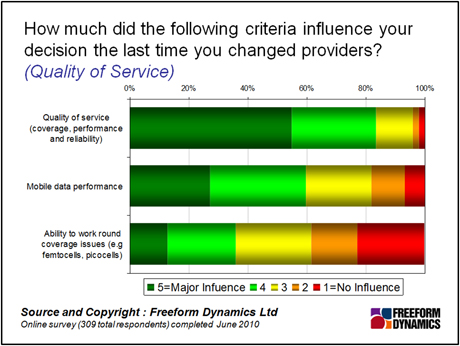Smartphones have become increasingly smart, providing access to multimedia content and social networking sites. On top of the boom in smartphones, there’s been solid growth in the use of mobile broadband PCs, and more recently, tablet devices.
These developments, along with the many attractive mobile broadband packages, have meant that mobile data usage has gone through exponential growth over the past few years.
But this growth isn’t without a price. From a user point of view, mobile broadband quality – which was already viewed as the poorer cousin of fixed in terms of its ability to deliver – has increasingly suffered as sales guys on the road accessing company resources compete with workers relaxing on their way home with a few YouTube videos.
Network congestion and dropped calls
Unsurprisingly, the outcome, as we have regularly found in our ongoing dialogue with enterprises using mobile data services, is congested, slow networks with frequent connection drops in busy areas at busy times.
Of course, any service can run the risk of disruption. However, when a data connection drops, it is arguably more of a problem than a dropped voice call, particularly if the data call relates to a critical, work-related transfer, and can result in a download needing to be restarted, or even in extreme cases, lost data.
With more enterprise applications now reliant on browser-based interfaces, losing a screen full of updates might not be a huge loss, but it’s very disruptive.
One could legitimately argue that mobile operators do themselves no favours by advertising data speeds that are rarely achieved in practice – something that has been shown to be the case in tests carried out by users and various bodies.
While this issue is an annoyance to consumers – albeit in some cases a significant one – for businesses, it may be much more of a problem, particularly when it affects key field service staff.
From a business perspective, these service issues only matter if companies genuinely care about data performance. But as recent research undertaken by Freeform Dynamics with enterprises showed, when it comes to selecting a mobile service provider, quality of service, encompassing areas such as coverage and reliability, and data performance are very high up the list of decision criteria.

There is no quick and easy fix to the problem. A network upgrade isn’t usually a particularly palatable option to service providers, and does little more than stop the problem getting too much worse, so mobile operators are now starting to look at a shorter-term fix using pricing.
Over recent months, there has been a marked shift by mobile service providers away from the all-you-can-eat packages towards capped data packages.
The idea behind this shift is to discourage the heavy users from abuse activity, such as peer-to-peer networking or 24/7 streaming, by making it economically crippling. Once you get over the cap, you pay through the nose – but capped usage is unlikely to affect most users. Various industry sources suggest that only a small proportion of users account for most of the mobile data used.
A major concern for businesses with this shift is that mobile – already a significant and growing outlay for many – will become much more unpredictable, and consequently, much more costly. Possibly, but the likelihood is that any concerns will be unfounded.
The caps of 500MB to 1GB per month that seem to be the norm allow for most typical business traffic, and are much more than most users will need. The 500MB cap, for example, will cover around 250 emails, 35 Word attachments and 25 Excel or PowerPoint attachments per day. A lot depends on the sizes of files transmitted, of course, but it gives a feel for what such caps might cover, and should offer some reassurance to businesses.
Monitoring data consumption
However, what the introduction of capped usage will bring about is the need to monitor data consumption much more closely, and time and tools will need to be allocated against this. Power users in the company who regularly need to go over a 1GB allowance should be relatively few in number, and may be able to justify overspend, while the rest should be covered by a fairly standard upper limit.
Capped usage is something that will need to be factored in to the budgets from here on in. Its inclusion might result in a price rise by service providers, but if it does, businesses need to look at whether they are getting proportionally more for their money – perhaps in the form of additional support or better security. Organisations must be prepared to negotiate.
Coming back to the original issue of service quality, the change in pricing structures that are increasingly being rolled out might help keep usage more in check. But the question remains, will the realisation that nothing really comes for free help the data quality issue by alleviating network traffic?
Whether a reduction in network traffic occurs remains to be seen, but in the meantime it makes sense for companies to do their homework on quality of service and coverage, and tread carefully with long-term contracts.
Through our research and insights, we help bridge the gap between technology buyers and sellers.





Have You Read This?
From Barcode Scanning to Smart Data Capture
Beyond the Barcode: Smart Data Capture
The Evolving Role of Converged Infrastructure in Modern IT
Evaluating the Potential of Hyper-Converged Storage
Kubernetes as an enterprise multi-cloud enabler
A CX perspective on the Contact Centre
Automation of SAP Master Data Management
Tackling the software skills crunch